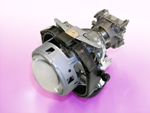Oct 27 2009
DSM has developed a new Arnite Low Outgassing PET XL Grade to specifically meet the needs of Adaptive Forward (AFX) Modules. The new material has been applied successfully in the production of a new Xenon AFX module for the new Mercedes S- Class, integrating additional features like Automatic High Beam Adjustment.
 Arnite Low Outgassing PET XL Grade
Arnite Low Outgassing PET XL Grade
Arnite PET XL, which fills the gap between Low Outgassing PBTs on one side and PPA, PEI, PES on the other, was developed in close cooperation with the Automotive Lighting GMBH Laboratory. The new grade was optimized to meet the toughest outgassing requirements – and offers additional benefits including thermal stability, excellent dimensional stability and high specific stiffness, required to limit resonant frequencies during idle engine conditions.
According to Automotive Lighting’s Test Department, DSM demonstrated its Innovative leadership by launching this new material that can be implemented for future Adaptive Forward Lighting Modules matching Low Moisture Absorption demands.
In addition to frames, Arnite PET XL is also highly suited for fog-lamp housings, lens holders and lamp sockets where it can be used to replace HHR materials such as PEI, PES and PPA.
Business Development Manager Automotive Lighting for DSM Engineering Plastics, Richard Frissen says: “Arnite PET XL is ideally suited to Replace PPA in this segment as it improves dynamic stability of the module at High Relative Humidities whilst simultaneously offering zero moisture emissions in use, thus addressing a known issue for Polyamides like PA66 and PPA. In addition, significant cost savings can be achieved compared to alternative materials such as PES and PEI. Due to its high specific stiffness above 150˚C, Arnite PET XL even offers weight optimization potential when compared to PBTs in this range.”
Today’s market conditions in automotive are driving and accelerating the need for innovation. In the automotive lighting segment this is done either by design, the introduction of (Day Time Running) LED Technology, and also by optimization of existing xenon and halogen systems. Xenon systems in particular contribute to drivers’ comfort and safety by increased light brightness and the integrated usage of Adaptive Forward lighting features.
DSM see’s clear market potential for new materials in the Automotive Lighting segment linked to DRL functionality, New Pedestrian Safety Concepts and further expansion of LED Technology.